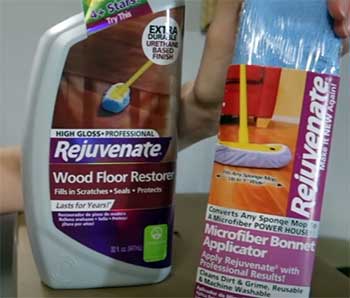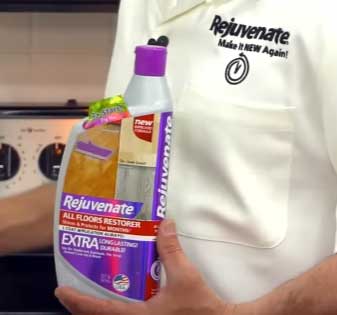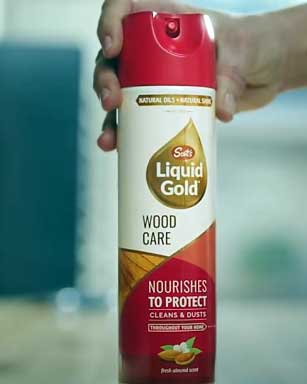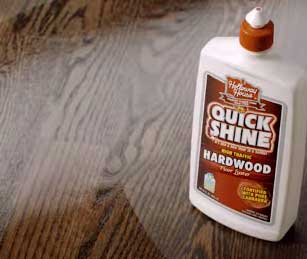I’m standing in my living room, staring at my hardwood floors that have seen better days, and I know you’ve been there too. Dull, scratched, and screaming for a revival, my floors needed help.
That’s when I stumbled upon Rejuvenate Wood Floor Restorer, and let me tell you, it’s a game-changer. If you’re tired of lackluster wood floors but don’t want to shell out thousands for refinishing, this product is your answer.
It’s easy, affordable, and delivers a glossy shine that makes your home feel brand new. Trust me, you’ll want this in your cleaning arsenal.
My Experience With Rejuvenate Wood Floor Restorer

My hardwood floors were a mess when I moved into my 1940s fixer-upper.
The oak planks in my kitchen and dining room had lost their shine, scratched from years of foot traffic, dog claws, and who-knows-what-else.
I couldn’t afford a professional refinish, so I started researching alternatives.
Rejuvenate Wood Floor Restorer caught my eye with its bold promises of reviving floors without sanding.
I was skeptical but desperate, so I grabbed a 32-ounce bottle from my local hardware store and got to work.
The process was surprisingly straightforward. I cleared the furniture, swept away dust, and used Rejuvenate’s Wood Floor Cleaner to prep the surface. The cleaner left my floors spotless, and I was already feeling hopeful.
Pouring the restorer in an “S” pattern, as the instructions suggested, felt a bit odd at first—like I was painting the floor with a mop. But as I spread it evenly with a microfiber pad, I could see the transformation happening.
The scratches faded, and a glossy sheen started to emerge. After an hour of drying, my floors looked like they belonged in a magazine. My husband even commented that the kitchen resembled a polished gymnasium.
I applied a second coat for extra shine, and the results were stunning. The floors weren’t perfect—deep gouges from moving furniture years ago were still faintly visible—but they were leagues better than before.
The high-gloss finish made the wood’s natural grain pop, and the whole room felt brighter. I’ve been living with these restored floors for months now, and they still turn heads when guests walk in.
The process took a single afternoon, and I was back to using my kitchen by evening. It’s not a permanent fix, but for the price and effort, it’s hard to beat.
Pros of Rejuvenate Wood Floor Restorer
- Easy Application for Anyone

You don’t need to be a DIY expert to use Rejuvenate.
The mop-on application is as simple as it gets.
Pour the product in an “S” pattern, spread it with a microfiber pad, and let it dry.
I was nervous about messing it up, but the instructions were clear, and the process felt intuitive.
Even if you’ve never tackled a home improvement project, you can handle this.
The bottle’s design makes pouring easy, and you don’t need fancy tools—just a mop and some elbow grease.
- Impressive Shine and Scratch Coverage
The glossy finish is where Rejuvenate shines—pun intended. My floors went from dull and lifeless to gleaming in just one coat. The product fills in light scratches beautifully, making them nearly invisible unless you’re looking closely.
I noticed this especially in high-traffic areas like my hallway, where scuffs from shoes and pet claws used to stand out. The shine also enhances the wood’s natural beauty, making my oak floors look richer and more vibrant.
- Time and Cost Savings
Refinishing hardwood floors can cost thousands and take days, not to mention the dust and disruption. Rejuvenate, on the other hand, is a fraction of the price—around $20 for a bottle that covers 525 square feet.
I finished my 300-square-foot kitchen and dining area in an afternoon without hiring a pro. The quick drying time (about an hour before walking, 24 hours for furniture) meant I didn’t have to upend my life. For budget-conscious homeowners like me, it’s a lifesaver.
- Safe and Low Odor
I was worried about chemical smells, especially with pets and kids around, but Rejuvenate surprised me. The odor was minimal and faded quickly as the product dried. It’s marketed as safe for pets and kids when used as directed, which gave me peace of mind.
I didn’t need to ventilate my house like a hazmat zone, and my dog was back to lounging on the floor in no time.
- Long-Lasting Protection
The restorer bonds to your floor’s existing polyurethane finish, creating a protective layer that resists stains and spills. I’ve spilled coffee and pasta sauce since applying it, and both wiped up easily without leaving marks.
The finish has held up well in my busy household, maintaining its shine for months with proper care. It’s not a permanent solution, but it extends the life of your floors significantly.
Cons of Rejuvenate Wood Floor Restorer
- Not Suitable for All Floors

Rejuvenate Professional Wood Floor Restorer is designed for unwaxed, polyurethane-finished hardwood floors only.
If you’ve got waxed floors, laminate, or tile, you’ll need their All Floors Restorer instead.
I learned this the hard way when I considered using it on my laminate bathroom floor—thankfully, I read the label first.
This limitation can be frustrating if you have mixed flooring types and want a single product for everything.
- Regular Reapplication Needed
The shine is gorgeous, but it doesn’t last forever. In high-traffic areas like my kitchen, I noticed some dulling after a few months. Rejuvenate recommends reapplying every three to six months, depending on wear.
This isn’t a dealbreaker, but it’s something to plan for. If you’re looking for a one-and-done solution, this isn’t it. You’ll need to commit to periodic maintenance to keep that glossy look.
- Potential for Streaking or Residue
I got lucky with a streak-free finish, but some users report streaks or a tacky residue if the product isn’t applied evenly. I made sure to mop lightly and avoid overworking the restorer, which helped.
If you rush or use too much product, you might end up with a hazy film. It’s fixable with a warm water rinse, but it’s an extra step you’d rather avoid.
- Not a Fix for Deep Damage
Rejuvenate is great for light scratches and dullness, but it’s not a miracle worker. Deep gouges or areas where the finish is completely worn off won’t look brand new.
My floors had some bad spots from years of neglect, and while Rejuvenate improved them, they’re still noticeable up close. If your floors are heavily damaged, you might need professional refinishing eventually.
Maintenance Tips For Rejuvenate-Treated Floors
- Clean Regularly with the Right Products
To keep your Rejuvenate-treated floors looking their best, regular cleaning is key. I use Rejuvenate’s Wood Floor Cleaner weekly to remove dirt and grime without dulling the finish. Avoid harsh chemicals like ammonia or oil-based cleaners, as they can strip the restorer.
A damp microfiber mop works wonders—just make sure it’s not soaking wet. I learned to wring mine out thoroughly to prevent water spots. Stick to pH-balanced cleaners designed for hardwood to maintain that glossy shine.
- Protect High-Traffic Areas
High-traffic spots, like entryways or kitchens, wear down faster. I placed area rugs in my hallway and near the sink to reduce wear. Felt pads on furniture legs are a must—trust me, you don’t want new scratches ruining your hard work.
I also ask guests to remove shoes at the door, which cuts down on scuffs. These small steps make a big difference in keeping your floors pristine.
- Reapply as Needed
Rejuvenate’s shine fades over time, especially in busy areas. I check my floors every few months and reapply when I notice dullness. The process is quick, and a single bottle goes a long way. Before reapplying, clean thoroughly to remove any residue.
I found that a second coat after a couple of hours boosts the shine even more. Plan for reapplication every three to six months, depending on how much foot traffic your floors get.
- Avoid Over-Saturation
When cleaning or reapplying, less is more. Too much water or product can lead to streaks or a sticky residue. I made the mistake of over-mopping once, and it took extra effort to fix.
Use a light hand when applying the restorer, and don’t work it into the surface—just spread it evenly. If you notice stickiness, a quick rinse with warm water and a damp cloth usually does the trick.
- Test Before Full Application
Always test Rejuvenate in a small, hidden area first. I tried it behind my couch before tackling the whole kitchen, and it saved me from potential mishaps.
This step ensures your floors are compatible and helps you get the hang of the application process. It’s a small time investment that can prevent big headaches.
Addressing Common Concerns
Before I wrap up, let’s tackle some real-world concerns about Rejuvenate. I’ve heard horror stories about floors looking worse after using it, so I approached it cautiously.
The key is preparation—clean your floors thoroughly with a compatible cleaner to avoid residue or streaking. Some users complain about a milky film, but I avoided this by following the instructions to a T and testing first.
If you’ve used oil-based cleaners like Murphy’s Oil Soap, strip them completely before applying Rejuvenate, as they can cause haze. For engineered hardwood, results can vary, so always test in a small area.
If your floors are waxed or unfinished, steer clear—this product is strictly for polyurethane-finished wood.
Comparison of Rejuvenate Wood Floor Restorer With Other Brands
- Rejuvenate Vs. Scott’s Liquid Gold Floor Restore

I pitted Rejuvenate against Scott’s Liquid Gold Floor Restore to see how it holds up.
Scott’s is a budget-friendly option, priced slightly lower than Rejuvenate at about $15 for a 24-ounce bottle that covers 300 square feet.
I tried it on my living room floors, and the application was simple—pour and mop, much like Rejuvenate.
However, Scott’s thinner formula was trickier to spread evenly, and I noticed pooling in some spots.
The shine was decent but lacked the vibrant gloss of Rejuvenate, and it didn’t fill light scratches as effectively. After a month, Scott’s finish started to dull in high-traffic areas, whereas Rejuvenate held strong.
Scott’s is a solid choice if you’re pinching pennies, but Rejuvenate’s superior shine and durability make it worth the extra few bucks for my hardwood floors.
- Rejuvenate Vs. Quick Shine Multi-Surface Floor Finish

Next up, I compared Rejuvenate to Quick Shine Multi-Surface Floor Finish, which is marketed for hardwood, vinyl, and tile.
I used Quick Shine on my kitchen floors a while back, and while it added a nice shine, the thicker formula was harder to apply evenly compared to Rejuvenate’s smooth, mop-on process.
Quick Shine’s waxy finish attracted dirt faster, and it didn’t hide scratches as well—my dog’s claw marks were still noticeable.
Priced similarly at around $20 for 27 ounces, Quick Shine covers slightly less area (400 square feet).
Its EPA Safer Choice certification is a plus for eco-conscious folks, but Rejuvenate’s targeted hardwood formula and longer-lasting gloss make it the better pick for my oak floors.
- Rejuvenate Vs. Rub ‘n Restore

Finally, I tested Rejuvenate against Rub ‘n Restore, a lesser-known polish for hardwood and other surfaces.
Rub ‘n Restore is applied with a cloth or sponge, which felt more labor-intensive than Rejuvenate’s mop-on method.
I tried it on a small section of my dining room, and while it restored some shine, the finish wasn’t as glossy, and the application took longer—about twice as long for the same area.
Priced at $25 for a 32-ounce bottle, it’s slightly more expensive and covers roughly the same area as Rejuvenate (500 square feet). Rub ‘n Restore claims to work on multiple surfaces, but for hardwood-specific restoration, Rejuvenate’s ease of use and bold shine outperformed it hands-down.
Frequently Asked Questions (FAQ)
The durability of Rejuvenate depends on your home’s foot traffic. In my moderately busy household, the high-gloss finish stayed vibrant for about four months before I noticed slight dulling in the kitchen. Rejuvenate suggests reapplying every three to six months for optimal shine. With proper maintenance, like regular cleaning and protecting high-traffic areas, you can stretch it closer to six months. Heavy traffic areas, like entryways, might need a touch-up sooner. A second coat during application can extend the life slightly, but plan on periodic reapplication to keep that glossy look.
Yes, it works, and I’m living proof. My dull, scratched oak floors transformed into a glossy showpiece after one application. It fills light scratches, restores shine, and protects against spills. That said, it’s not magic—deep gouges or heavily worn areas won’t look brand new. Some users report streaking or residue, but I avoided this by cleaning thoroughly and applying evenly. If you follow the instructions and prep your floors, you’ll see a dramatic improvement. It’s a temporary fix, but for the price and effort, the results are impressive.
For unwaxed, polyurethane-finished hardwood floors, Rejuvenate is excellent. It restored my oak floors’ shine and hid minor scratches without sanding. However, it’s not suitable for waxed, unfinished, or non-polyurethane-coated floors, which can lead to poor results or damage. Some professionals warn against it, claiming it’s a “contaminant” that complicates future refinishing, but I found no issues for short-term use. If your floors are compatible and you’re looking for a quick, affordable refresh, it’s a great choice. Always test first to ensure it works for your specific floors.
Choosing between Rejuvenate and Bona depends on your needs. Rejuvenate is easier to apply and more affordable, delivering a bold, glossy finish that’s perfect for DIYers. I found it transformed my floors with minimal effort. Bona’s High-Gloss Polish offers a professional-grade shine and excellent scratch coverage but requires more prep and costs more. Rejuvenate’s forgiving application suits beginners, while Bona’s results feel more refined but demand precision. For budget and ease, I lean toward Rejuvenate, but if you want a premium finish and don’t mind the extra work, Bona’s a strong contender.
Why Rejuvenate Is Worth Your Money?
After months of living with my revitalized floors, I can’t recommend Rejuvenate Wood Floor Restorer enough. It’s a budget-friendly, easy-to-use solution that breathes new life into tired hardwood without the hassle of refinishing.
You’ll love the glossy shine and how it hides those pesky scratches. Sure, it’s not perfect for every floor or a forever fix, but for the price and results, it’s hard to beat.
Grab a bottle, give your floors the glow-up they deserve, and enjoy the compliments from everyone who walks in.
